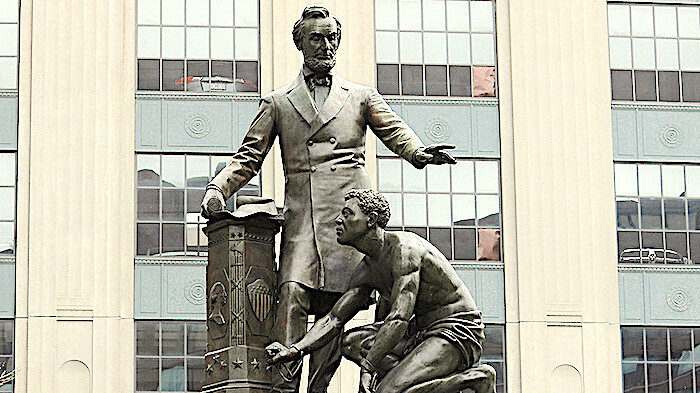The morning after Abraham Lincoln died in 1865, a former enslaved woman named Charlotte Scott asked her employer to send $5 to help build a monument to the former president. In 1876, through donations by the enslaved people he had freed and black veterans of the Union Army, a statue depicting Lincoln holding his hand over a kneeling black man - a figure modeled on Archer Alexander, the last man captured under the Fugitive Slave Act - was erected in Washington, and a copy of it in Boston, the hometown of its sculptor, Thomas Ball.
Now the authorities in Boston have removed the statue that Scott wanted to see built because some progressives found it offensive.
There have been cries that it needs to be taken in a certain context, which is why it was taken down. Yet at whichever context of emancipation you care to look, there is not a single way you can see that doesn't show Abraham Lincoln at the apex. If there is reservation that the monument does not tell the whole story, we should take into consideration what Frederick Douglass, the famous 19th century black abolitionist, said about it.
"Admirable as is the monument by Mr. Ball... it does not, as it seems to me, tell the whole truth, and perhaps no one monument could be made to tell the whole truth of any subject which it might be designed to illustrate."An emphasis needs to be placed on the second part of that statement. There is no way that any single monument is ever going to tell the entire story of history. Monuments aren't meant to. Each one in their creation carries a specific message or idea, paying tribute to a historical figure or simply an idea that must be considered by society. In this particular instance, we see a statue that was commissioned with the express purpose of honoring Lincoln's key role in freeing slaves.
I'll go a step beyond and say that anyone who claims that this makes African Americans look bad - because the black figure is half-kneeling while the white man stands above him - is a crazy person. Lincoln is depicted as in the process of helping the man to his feet, a metaphorical illustration of what he achieved in exchanging the power that slaveholders had over their slaves for the acknowledgment of their rights as human beings.
Let's actually look at the historical context. The US government under Lincoln acknowledged the rights of people who were slaves as equal to anyone else in the nation. It is a promise of the Constitution that Frederick Douglass often spoke about and made sure to hold the United States government to that standard. What Lincoln did was he removed a burden from all slaves and made sure that the United States would acknowledge and protect their God-given rights.
Abraham Lincoln is on Mount Rushmore for a reason. He is a president that is admired by both sides of the political divide, and by people of all colors. In fact, he is often noted to be Barack Obama's favorite president. With context introduced, there really is no reason to remove the statue.
All that Boston is doing is removing one of the greatest American leaders from public view because some overly sensitive and ill-informed people have apparently had their feelings hurt. If we prioritize people's feelings over history, we exchange the ability to learn and improve for kowtowing to the whinging of people who are too sensitive to realize and celebrate greatness.




Reader Comments
Lincoln's Emancipation Proclamation declared that slaves in the Confederate states were free while those in any area under union army control were to be kept in bondage. He "freed" slaves that he had no control over while keeping enslaved those he did have the ability to set free.